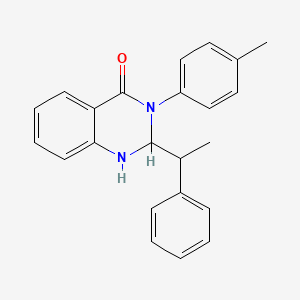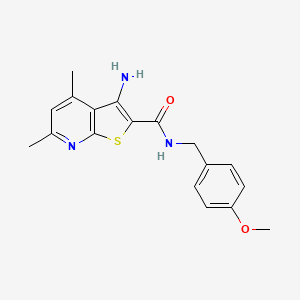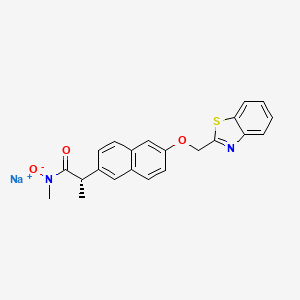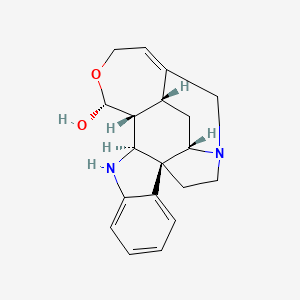
トリメトプリム
概要
説明
Trimethoprim is an antibiotic primarily used to treat bacterial infections, particularly urinary tract infections. It is also effective against middle ear infections and traveler’s diarrhea. Trimethoprim works by inhibiting the bacterial enzyme dihydrofolate reductase, which is essential for the production of tetrahydrofolic acid, a precursor in the synthesis of bacterial DNA .
作用機序
Target of Action
Trimethoprim primarily targets the bacterial enzyme dihydrofolate reductase (DHFR) . DHFR plays a crucial role in the synthesis of purine and pyrimidine nucleotides, which are essential for bacterial DNA synthesis .
Mode of Action
Trimethoprim acts as a selective inhibitor of bacterial DHFR . By inhibiting DHFR, it prevents the conversion of dihydrofolate to tetrahydrofolate . This disruption in the conversion process leads to a halt in the synthesis of purine and pyrimidine nucleotides, thereby disrupting bacterial DNA synthesis and leading to cell death .
Biochemical Pathways
The primary biochemical pathway affected by trimethoprim is the dihydrofolate pathway . By inhibiting DHFR, trimethoprim prevents the formation of tetrahydrofolic acid (THF) from dihydrofolic acid (DHF) . THF is necessary for the biosynthesis of bacterial nucleic acids and proteins . The inhibition of this pathway disrupts bacterial DNA synthesis, ultimately preventing bacterial survival .
Pharmacokinetics
Trimethoprim is rapidly absorbed, with steady-state concentrations achieved after approximately 3 days of repeat administration . Peak serum concentrations are reached within 1 to 4 hours following the administration of a single dose . The elimination half-life of trimethoprim ranges between 6 and 17 hours . These pharmacokinetic properties impact the bioavailability of trimethoprim, influencing its effectiveness in treating infections.
Result of Action
The molecular and cellular effects of trimethoprim’s action primarily involve the disruption of bacterial DNA synthesis . By inhibiting the formation of THF, an essential precursor in the thymidine synthesis pathway, trimethoprim prevents the synthesis of bacterial DNA . This disruption in DNA synthesis leads to bacterial cell death .
Action Environment
Environmental factors can influence the action, efficacy, and stability of trimethoprim. For instance, the pH of the environment can impact the ionization state of trimethoprim, which in turn affects its adsorption and overall effectiveness . Additionally, the presence of microplastics in the environment can enhance the adsorption of trimethoprim in soil environments . These factors need to be considered when assessing the fate and transport of trimethoprim in various environments .
科学的研究の応用
Trimethoprim has a wide range of applications in scientific research:
Chemistry: Used as a template for synthesizing new antibacterial agents and studying enzyme inhibition.
Biology: Employed in studies of bacterial resistance mechanisms and metabolic pathways.
Medicine: Widely used in clinical trials for treating bacterial infections and as a prophylactic agent in immunocompromised patients.
Industry: Utilized in the formulation of combination drugs with other antibiotics like sulfamethoxazole
生化学分析
Biochemical Properties
Trimethoprim plays a crucial role in biochemical reactions by inhibiting the enzyme dihydrofolate reductase. This enzyme is responsible for the reduction of dihydrofolic acid to tetrahydrofolic acid, a precursor necessary for the synthesis of thymidine, purines, and certain amino acids. By blocking this enzyme, trimethoprim prevents the formation of tetrahydrofolic acid, thereby inhibiting bacterial DNA synthesis and cell division . Trimethoprim interacts specifically with bacterial dihydrofolate reductase, binding to it more strongly than to the mammalian counterpart, which accounts for its selective toxicity towards bacteria .
Cellular Effects
Trimethoprim affects various types of cells and cellular processes. In bacterial cells, it disrupts DNA synthesis by inhibiting the production of tetrahydrofolic acid. This inhibition leads to a halt in cell division and ultimately results in bacterial cell death . Trimethoprim also impacts cell signaling pathways and gene expression by interfering with the folate metabolism pathway, which is crucial for the synthesis of nucleotides and amino acids . In mammalian cells, trimethoprim can cause side effects such as nausea, vomiting, and rash, which are related to its impact on folate metabolism .
Molecular Mechanism
The molecular mechanism of trimethoprim involves its binding to the active site of dihydrofolate reductase, thereby inhibiting the enzyme’s activity. This binding is highly specific and much stronger for the bacterial enzyme compared to the mammalian enzyme . By inhibiting dihydrofolate reductase, trimethoprim prevents the conversion of dihydrofolic acid to tetrahydrofolic acid, leading to a depletion of tetrahydrofolic acid and subsequent inhibition of DNA synthesis . This mechanism of action is the basis for its antibacterial properties.
Temporal Effects in Laboratory Settings
In laboratory settings, the effects of trimethoprim can change over time. Studies have shown that trimethoprim remains stable under various conditions, but its efficacy can decrease due to bacterial resistance mechanisms . Long-term exposure to trimethoprim can lead to the development of resistance in bacterial populations, which is a significant concern in clinical settings . Additionally, trimethoprim can cause adverse effects such as acute kidney injury and hyperkalemia in patients, particularly in older adults .
Dosage Effects in Animal Models
The effects of trimethoprim vary with different dosages in animal models. At therapeutic doses, trimethoprim effectively treats bacterial infections without causing significant adverse effects . At higher doses, trimethoprim can cause toxic effects such as bone marrow suppression and changes in the hematopoietic system . In animal studies, trimethoprim has been shown to cause teratogenic effects at doses higher than those recommended for therapeutic use .
Metabolic Pathways
Trimethoprim is involved in the metabolic pathway of folate synthesis. It inhibits dihydrofolate reductase, preventing the formation of tetrahydrofolic acid from dihydrofolic acid . This inhibition disrupts the synthesis of nucleotides and amino acids, which are essential for DNA and RNA synthesis . Trimethoprim’s action on the folate pathway also affects the levels of various metabolites, leading to a decrease in nucleotide synthesis and an increase in stress-related metabolites .
Transport and Distribution
Trimethoprim is rapidly absorbed following oral administration and has a high bioavailability . It is distributed widely in the body, with approximately 44% bound to plasma proteins . Trimethoprim achieves high concentrations in tissues such as the kidneys and prostate, which is beneficial for treating urinary tract infections . It is also excreted primarily through the kidneys, with a significant portion of the drug being eliminated unchanged in the urine .
Subcellular Localization
Trimethoprim’s subcellular localization is primarily within the cytoplasm, where it exerts its inhibitory effects on dihydrofolate reductase . The drug does not require specific targeting signals or post-translational modifications to reach its site of action. Its activity is dependent on its ability to diffuse into bacterial cells and bind to the enzyme . This localization is crucial for its effectiveness in inhibiting bacterial DNA synthesis and preventing cell division .
準備方法
Synthetic Routes and Reaction Conditions: Trimethoprim is synthesized through a multi-step process involving the condensation of 3,4,5-trimethoxybenzaldehyde with guanidine to form 2,4-diamino-5-(3,4,5-trimethoxybenzyl)pyrimidine. The reaction typically occurs under basic conditions with the use of a strong base such as sodium hydroxide .
Industrial Production Methods: In industrial settings, the synthesis of trimethoprim involves large-scale batch processes. The key steps include the preparation of intermediates, followed by their condensation and purification. The final product is obtained through crystallization and drying .
Types of Reactions:
Oxidation: Trimethoprim can undergo oxidation reactions, particularly at the methoxy groups, leading to the formation of quinone derivatives.
Reduction: The nitro group in trimethoprim can be reduced to an amine under specific conditions.
Substitution: Trimethoprim can participate in nucleophilic substitution reactions, especially at the aromatic ring positions.
Common Reagents and Conditions:
Oxidation: Reagents such as potassium permanganate or chromium trioxide are commonly used.
Reduction: Catalytic hydrogenation or the use of reducing agents like sodium borohydride.
Substitution: Halogenating agents or nucleophiles like amines and thiols.
Major Products:
Oxidation: Quinone derivatives.
Reduction: Amino derivatives.
Substitution: Various substituted aromatic compounds.
類似化合物との比較
Pyrimethamine: Used primarily as an antimalarial agent.
Methotrexate: Used in cancer therapy and autoimmune diseases.
Sulfamethoxazole: Often combined with trimethoprim for synergistic effects
Uniqueness: Trimethoprim is unique in its selective inhibition of bacterial dihydrofolate reductase, making it highly effective against a broad spectrum of bacterial infections. Its combination with sulfamethoxazole enhances its antibacterial efficacy and reduces the likelihood of resistance development .
特性
IUPAC Name |
5-[(3,4,5-trimethoxyphenyl)methyl]pyrimidine-2,4-diamine | |
|---|---|---|
| Source | PubChem | |
| URL | https://pubchem.ncbi.nlm.nih.gov | |
| Description | Data deposited in or computed by PubChem | |
InChI |
InChI=1S/C14H18N4O3/c1-19-10-5-8(6-11(20-2)12(10)21-3)4-9-7-17-14(16)18-13(9)15/h5-7H,4H2,1-3H3,(H4,15,16,17,18) | |
| Source | PubChem | |
| URL | https://pubchem.ncbi.nlm.nih.gov | |
| Description | Data deposited in or computed by PubChem | |
InChI Key |
IEDVJHCEMCRBQM-UHFFFAOYSA-N | |
| Source | PubChem | |
| URL | https://pubchem.ncbi.nlm.nih.gov | |
| Description | Data deposited in or computed by PubChem | |
Canonical SMILES |
COC1=CC(=CC(=C1OC)OC)CC2=CN=C(N=C2N)N | |
| Source | PubChem | |
| URL | https://pubchem.ncbi.nlm.nih.gov | |
| Description | Data deposited in or computed by PubChem | |
Molecular Formula |
C14H18N4O3 | |
| Record name | TRIMETHOPRIM | |
| Source | CAMEO Chemicals | |
| URL | https://cameochemicals.noaa.gov/chemical/21180 | |
| Description | CAMEO Chemicals is a chemical database designed for people who are involved in hazardous material incident response and planning. CAMEO Chemicals contains a library with thousands of datasheets containing response-related information and recommendations for hazardous materials that are commonly transported, used, or stored in the United States. CAMEO Chemicals was developed by the National Oceanic and Atmospheric Administration's Office of Response and Restoration in partnership with the Environmental Protection Agency's Office of Emergency Management. | |
| Explanation | CAMEO Chemicals and all other CAMEO products are available at no charge to those organizations and individuals (recipients) responsible for the safe handling of chemicals. However, some of the chemical data itself is subject to the copyright restrictions of the companies or organizations that provided the data. | |
| Record name | trimethoprim | |
| Source | Wikipedia | |
| URL | https://en.wikipedia.org/wiki/Trimethoprim | |
| Description | Chemical information link to Wikipedia. | |
| Source | PubChem | |
| URL | https://pubchem.ncbi.nlm.nih.gov | |
| Description | Data deposited in or computed by PubChem | |
DSSTOX Substance ID |
DTXSID3023712 | |
| Record name | Trimethoprim | |
| Source | EPA DSSTox | |
| URL | https://comptox.epa.gov/dashboard/DTXSID3023712 | |
| Description | DSSTox provides a high quality public chemistry resource for supporting improved predictive toxicology. | |
Molecular Weight |
290.32 g/mol | |
| Source | PubChem | |
| URL | https://pubchem.ncbi.nlm.nih.gov | |
| Description | Data deposited in or computed by PubChem | |
Physical Description |
Trimethoprim is an odorless white powder. Bitter taste. (NTP, 1992), Solid | |
| Record name | TRIMETHOPRIM | |
| Source | CAMEO Chemicals | |
| URL | https://cameochemicals.noaa.gov/chemical/21180 | |
| Description | CAMEO Chemicals is a chemical database designed for people who are involved in hazardous material incident response and planning. CAMEO Chemicals contains a library with thousands of datasheets containing response-related information and recommendations for hazardous materials that are commonly transported, used, or stored in the United States. CAMEO Chemicals was developed by the National Oceanic and Atmospheric Administration's Office of Response and Restoration in partnership with the Environmental Protection Agency's Office of Emergency Management. | |
| Explanation | CAMEO Chemicals and all other CAMEO products are available at no charge to those organizations and individuals (recipients) responsible for the safe handling of chemicals. However, some of the chemical data itself is subject to the copyright restrictions of the companies or organizations that provided the data. | |
| Record name | Trimethoprim | |
| Source | Human Metabolome Database (HMDB) | |
| URL | http://www.hmdb.ca/metabolites/HMDB0014583 | |
| Description | The Human Metabolome Database (HMDB) is a freely available electronic database containing detailed information about small molecule metabolites found in the human body. | |
| Explanation | HMDB is offered to the public as a freely available resource. Use and re-distribution of the data, in whole or in part, for commercial purposes requires explicit permission of the authors and explicit acknowledgment of the source material (HMDB) and the original publication (see the HMDB citing page). We ask that users who download significant portions of the database cite the HMDB paper in any resulting publications. | |
Solubility |
less than 1 mg/mL at 75 °F (NTP, 1992), ... Very slightly soluble in water and slightly soluble in alcohol., Soluble in N,N-dimethylacetamide (DMAC) at 13.86; benzyl alcohol at 7.29; propylene glycol at 2.57; chloroform at 1.82; methanol at 1.21; ether at 0.003; benzene at 0.002 g/100 ml at 25 °C., In water, 400 mg/l @ 25 °C, 6.15e-01 g/L | |
| Record name | TRIMETHOPRIM | |
| Source | CAMEO Chemicals | |
| URL | https://cameochemicals.noaa.gov/chemical/21180 | |
| Description | CAMEO Chemicals is a chemical database designed for people who are involved in hazardous material incident response and planning. CAMEO Chemicals contains a library with thousands of datasheets containing response-related information and recommendations for hazardous materials that are commonly transported, used, or stored in the United States. CAMEO Chemicals was developed by the National Oceanic and Atmospheric Administration's Office of Response and Restoration in partnership with the Environmental Protection Agency's Office of Emergency Management. | |
| Explanation | CAMEO Chemicals and all other CAMEO products are available at no charge to those organizations and individuals (recipients) responsible for the safe handling of chemicals. However, some of the chemical data itself is subject to the copyright restrictions of the companies or organizations that provided the data. | |
| Record name | Trimethoprim | |
| Source | DrugBank | |
| URL | https://www.drugbank.ca/drugs/DB00440 | |
| Description | The DrugBank database is a unique bioinformatics and cheminformatics resource that combines detailed drug (i.e. chemical, pharmacological and pharmaceutical) data with comprehensive drug target (i.e. sequence, structure, and pathway) information. | |
| Explanation | Creative Common's Attribution-NonCommercial 4.0 International License (http://creativecommons.org/licenses/by-nc/4.0/legalcode) | |
| Record name | TRIMETHOPRIM | |
| Source | Hazardous Substances Data Bank (HSDB) | |
| URL | https://pubchem.ncbi.nlm.nih.gov/source/hsdb/6781 | |
| Description | The Hazardous Substances Data Bank (HSDB) is a toxicology database that focuses on the toxicology of potentially hazardous chemicals. It provides information on human exposure, industrial hygiene, emergency handling procedures, environmental fate, regulatory requirements, nanomaterials, and related areas. The information in HSDB has been assessed by a Scientific Review Panel. | |
| Record name | Trimethoprim | |
| Source | Human Metabolome Database (HMDB) | |
| URL | http://www.hmdb.ca/metabolites/HMDB0014583 | |
| Description | The Human Metabolome Database (HMDB) is a freely available electronic database containing detailed information about small molecule metabolites found in the human body. | |
| Explanation | HMDB is offered to the public as a freely available resource. Use and re-distribution of the data, in whole or in part, for commercial purposes requires explicit permission of the authors and explicit acknowledgment of the source material (HMDB) and the original publication (see the HMDB citing page). We ask that users who download significant portions of the database cite the HMDB paper in any resulting publications. | |
Mechanism of Action |
Trimethoprim is a reversible inhibitor of dihydrofolate reductase, one of the principal enzymes catalyzing the formation of tetrahydrofolic acid (THF) from dihydrofolic acid (DHF). Tetrahydrofolic acid is necessary for the biosynthesis of bacterial nucleic acids and proteins and ultimately for continued bacterial survival - inhibiting its synthesis, then, results in bactericidal activity. Trimethoprim binds with a much stronger affinity to bacterial dihydrofolate reductase as compared to its mammalian counterpart, allowing trimethoprim to selectively interfere with bacterial biosynthetic processes. Trimethoprim is often given in combination with sulfamethoxazole, which inhibits the preceding step in bacterial protein synthesis - given together, sulfamethoxazole and trimethoprim inhibit two consecutive steps in the biosynthesis of bacterial nucleic acids and proteins. As a monotherapy trimethoprim is considered bacteriostatic, but in combination with sulfamethoxazole is thought to exert bactericidal activity., Trimethoprim is a bacteriostatic lipophilic weak base structurally related to pyrimethamine. It binds to and reversibly inhibits the bacterial enzyme dihydrofolate reductase, selectively blocking conversion of dihydrofolic acid to its functional form, tetrahydrofolic acid. This depletes folate, an essential cofactor in the biosynthesis of nucleic acids, resulting in interference with bacterial nucleic acid and protein production. Bacterial dihydrofolate reductase is approximately 50,000 to 60,000 times more tightly bound by trimethoprim than is the corresponding mammalian enzyme., To determine the incidence & severity of hyperkalemia during trimethoprim therapy, 30 consecutive patients with acquired immunodeficiency syndrome receiving high-dose (20 mg/kg/day) trimethoprim were studied; in addition, the mechanism of trimethoprim-induced hyperkalemia was investigated in rats. Trimethoprim increased serum potassium concn by 0.6 mmol/l despite normal adrenocortical function & glomerular filtration rate. Serum potassium levels >5 mmol/l were observed during trimethoprim treatment in 15 of 30 patients. In rats, iv trimethoprim inhibited renal potassium excretion by 40% & increased sodium excretion by 46%. It was concluded that trimethoprim blocks apical membrane sodium channels in the mammalian distal nephron. As a consequence, the transepithelial voltage is reduced & potassium secretion is inhibited. Decreased renal potassium excretion secondary to these direct effects on kidney tubules leads to hyperkalemia in a substantial number of patients being treated with trimethoprim-containing drugs. | |
| Record name | Trimethoprim | |
| Source | DrugBank | |
| URL | https://www.drugbank.ca/drugs/DB00440 | |
| Description | The DrugBank database is a unique bioinformatics and cheminformatics resource that combines detailed drug (i.e. chemical, pharmacological and pharmaceutical) data with comprehensive drug target (i.e. sequence, structure, and pathway) information. | |
| Explanation | Creative Common's Attribution-NonCommercial 4.0 International License (http://creativecommons.org/licenses/by-nc/4.0/legalcode) | |
| Record name | TRIMETHOPRIM | |
| Source | Hazardous Substances Data Bank (HSDB) | |
| URL | https://pubchem.ncbi.nlm.nih.gov/source/hsdb/6781 | |
| Description | The Hazardous Substances Data Bank (HSDB) is a toxicology database that focuses on the toxicology of potentially hazardous chemicals. It provides information on human exposure, industrial hygiene, emergency handling procedures, environmental fate, regulatory requirements, nanomaterials, and related areas. The information in HSDB has been assessed by a Scientific Review Panel. | |
Color/Form |
White to cream, crystalline powder | |
CAS No. |
738-70-5 | |
| Record name | TRIMETHOPRIM | |
| Source | CAMEO Chemicals | |
| URL | https://cameochemicals.noaa.gov/chemical/21180 | |
| Description | CAMEO Chemicals is a chemical database designed for people who are involved in hazardous material incident response and planning. CAMEO Chemicals contains a library with thousands of datasheets containing response-related information and recommendations for hazardous materials that are commonly transported, used, or stored in the United States. CAMEO Chemicals was developed by the National Oceanic and Atmospheric Administration's Office of Response and Restoration in partnership with the Environmental Protection Agency's Office of Emergency Management. | |
| Explanation | CAMEO Chemicals and all other CAMEO products are available at no charge to those organizations and individuals (recipients) responsible for the safe handling of chemicals. However, some of the chemical data itself is subject to the copyright restrictions of the companies or organizations that provided the data. | |
| Record name | Trimethoprim | |
| Source | CAS Common Chemistry | |
| URL | https://commonchemistry.cas.org/detail?cas_rn=738-70-5 | |
| Description | CAS Common Chemistry is an open community resource for accessing chemical information. Nearly 500,000 chemical substances from CAS REGISTRY cover areas of community interest, including common and frequently regulated chemicals, and those relevant to high school and undergraduate chemistry classes. This chemical information, curated by our expert scientists, is provided in alignment with our mission as a division of the American Chemical Society. | |
| Explanation | The data from CAS Common Chemistry is provided under a CC-BY-NC 4.0 license, unless otherwise stated. | |
| Record name | Trimethoprim [USAN:USP:INN:BAN:JAN] | |
| Source | ChemIDplus | |
| URL | https://pubchem.ncbi.nlm.nih.gov/substance/?source=chemidplus&sourceid=0000738705 | |
| Description | ChemIDplus is a free, web search system that provides access to the structure and nomenclature authority files used for the identification of chemical substances cited in National Library of Medicine (NLM) databases, including the TOXNET system. | |
| Record name | Trimethoprim | |
| Source | DrugBank | |
| URL | https://www.drugbank.ca/drugs/DB00440 | |
| Description | The DrugBank database is a unique bioinformatics and cheminformatics resource that combines detailed drug (i.e. chemical, pharmacological and pharmaceutical) data with comprehensive drug target (i.e. sequence, structure, and pathway) information. | |
| Explanation | Creative Common's Attribution-NonCommercial 4.0 International License (http://creativecommons.org/licenses/by-nc/4.0/legalcode) | |
| Record name | trimethoprim | |
| Source | DTP/NCI | |
| URL | https://dtp.cancer.gov/dtpstandard/servlet/dwindex?searchtype=NSC&outputformat=html&searchlist=757370 | |
| Description | The NCI Development Therapeutics Program (DTP) provides services and resources to the academic and private-sector research communities worldwide to facilitate the discovery and development of new cancer therapeutic agents. | |
| Explanation | Unless otherwise indicated, all text within NCI products is free of copyright and may be reused without our permission. Credit the National Cancer Institute as the source. | |
| Record name | trimethoprim | |
| Source | DTP/NCI | |
| URL | https://dtp.cancer.gov/dtpstandard/servlet/dwindex?searchtype=NSC&outputformat=html&searchlist=106568 | |
| Description | The NCI Development Therapeutics Program (DTP) provides services and resources to the academic and private-sector research communities worldwide to facilitate the discovery and development of new cancer therapeutic agents. | |
| Explanation | Unless otherwise indicated, all text within NCI products is free of copyright and may be reused without our permission. Credit the National Cancer Institute as the source. | |
| Record name | Trimethoprim | |
| Source | EPA DSSTox | |
| URL | https://comptox.epa.gov/dashboard/DTXSID3023712 | |
| Description | DSSTox provides a high quality public chemistry resource for supporting improved predictive toxicology. | |
| Record name | Trimethoprim | |
| Source | European Chemicals Agency (ECHA) | |
| URL | https://echa.europa.eu/substance-information/-/substanceinfo/100.010.915 | |
| Description | The European Chemicals Agency (ECHA) is an agency of the European Union which is the driving force among regulatory authorities in implementing the EU's groundbreaking chemicals legislation for the benefit of human health and the environment as well as for innovation and competitiveness. | |
| Explanation | Use of the information, documents and data from the ECHA website is subject to the terms and conditions of this Legal Notice, and subject to other binding limitations provided for under applicable law, the information, documents and data made available on the ECHA website may be reproduced, distributed and/or used, totally or in part, for non-commercial purposes provided that ECHA is acknowledged as the source: "Source: European Chemicals Agency, http://echa.europa.eu/". Such acknowledgement must be included in each copy of the material. ECHA permits and encourages organisations and individuals to create links to the ECHA website under the following cumulative conditions: Links can only be made to webpages that provide a link to the Legal Notice page. | |
| Record name | TRIMETHOPRIM | |
| Source | FDA Global Substance Registration System (GSRS) | |
| URL | https://gsrs.ncats.nih.gov/ginas/app/beta/substances/AN164J8Y0X | |
| Description | The FDA Global Substance Registration System (GSRS) enables the efficient and accurate exchange of information on what substances are in regulated products. Instead of relying on names, which vary across regulatory domains, countries, and regions, the GSRS knowledge base makes it possible for substances to be defined by standardized, scientific descriptions. | |
| Explanation | Unless otherwise noted, the contents of the FDA website (www.fda.gov), both text and graphics, are not copyrighted. They are in the public domain and may be republished, reprinted and otherwise used freely by anyone without the need to obtain permission from FDA. Credit to the U.S. Food and Drug Administration as the source is appreciated but not required. | |
| Record name | TRIMETHOPRIM | |
| Source | Hazardous Substances Data Bank (HSDB) | |
| URL | https://pubchem.ncbi.nlm.nih.gov/source/hsdb/6781 | |
| Description | The Hazardous Substances Data Bank (HSDB) is a toxicology database that focuses on the toxicology of potentially hazardous chemicals. It provides information on human exposure, industrial hygiene, emergency handling procedures, environmental fate, regulatory requirements, nanomaterials, and related areas. The information in HSDB has been assessed by a Scientific Review Panel. | |
| Record name | Trimethoprim | |
| Source | Human Metabolome Database (HMDB) | |
| URL | http://www.hmdb.ca/metabolites/HMDB0014583 | |
| Description | The Human Metabolome Database (HMDB) is a freely available electronic database containing detailed information about small molecule metabolites found in the human body. | |
| Explanation | HMDB is offered to the public as a freely available resource. Use and re-distribution of the data, in whole or in part, for commercial purposes requires explicit permission of the authors and explicit acknowledgment of the source material (HMDB) and the original publication (see the HMDB citing page). We ask that users who download significant portions of the database cite the HMDB paper in any resulting publications. | |
Melting Point |
390 to 397 °F (NTP, 1992), 199-203 °C, 199 - 203 °C | |
| Record name | TRIMETHOPRIM | |
| Source | CAMEO Chemicals | |
| URL | https://cameochemicals.noaa.gov/chemical/21180 | |
| Description | CAMEO Chemicals is a chemical database designed for people who are involved in hazardous material incident response and planning. CAMEO Chemicals contains a library with thousands of datasheets containing response-related information and recommendations for hazardous materials that are commonly transported, used, or stored in the United States. CAMEO Chemicals was developed by the National Oceanic and Atmospheric Administration's Office of Response and Restoration in partnership with the Environmental Protection Agency's Office of Emergency Management. | |
| Explanation | CAMEO Chemicals and all other CAMEO products are available at no charge to those organizations and individuals (recipients) responsible for the safe handling of chemicals. However, some of the chemical data itself is subject to the copyright restrictions of the companies or organizations that provided the data. | |
| Record name | Trimethoprim | |
| Source | DrugBank | |
| URL | https://www.drugbank.ca/drugs/DB00440 | |
| Description | The DrugBank database is a unique bioinformatics and cheminformatics resource that combines detailed drug (i.e. chemical, pharmacological and pharmaceutical) data with comprehensive drug target (i.e. sequence, structure, and pathway) information. | |
| Explanation | Creative Common's Attribution-NonCommercial 4.0 International License (http://creativecommons.org/licenses/by-nc/4.0/legalcode) | |
| Record name | Trimethoprim | |
| Source | Human Metabolome Database (HMDB) | |
| URL | http://www.hmdb.ca/metabolites/HMDB0014583 | |
| Description | The Human Metabolome Database (HMDB) is a freely available electronic database containing detailed information about small molecule metabolites found in the human body. | |
| Explanation | HMDB is offered to the public as a freely available resource. Use and re-distribution of the data, in whole or in part, for commercial purposes requires explicit permission of the authors and explicit acknowledgment of the source material (HMDB) and the original publication (see the HMDB citing page). We ask that users who download significant portions of the database cite the HMDB paper in any resulting publications. | |
Synthesis routes and methods I
Procedure details








Synthesis routes and methods II
Procedure details





Retrosynthesis Analysis
AI-Powered Synthesis Planning: Our tool employs the Template_relevance Pistachio, Template_relevance Bkms_metabolic, Template_relevance Pistachio_ringbreaker, Template_relevance Reaxys, Template_relevance Reaxys_biocatalysis model, leveraging a vast database of chemical reactions to predict feasible synthetic routes.
One-Step Synthesis Focus: Specifically designed for one-step synthesis, it provides concise and direct routes for your target compounds, streamlining the synthesis process.
Accurate Predictions: Utilizing the extensive PISTACHIO, BKMS_METABOLIC, PISTACHIO_RINGBREAKER, REAXYS, REAXYS_BIOCATALYSIS database, our tool offers high-accuracy predictions, reflecting the latest in chemical research and data.
Strategy Settings
| Precursor scoring | Relevance Heuristic |
|---|---|
| Min. plausibility | 0.01 |
| Model | Template_relevance |
| Template Set | Pistachio/Bkms_metabolic/Pistachio_ringbreaker/Reaxys/Reaxys_biocatalysis |
| Top-N result to add to graph | 6 |
Feasible Synthetic Routes
Q1: How does trimethoprim exert its antibacterial effect?
A1: Trimethoprim inhibits bacterial dihydrofolate reductase (DHFR), an enzyme essential for the synthesis of tetrahydrofolic acid. Tetrahydrofolic acid is crucial for the production of purines and pyrimidines, which are the building blocks of DNA and RNA. By inhibiting DHFR, trimethoprim disrupts bacterial DNA and RNA synthesis, ultimately leading to bacterial cell death. [, , , , ]
Q2: What is the significance of dihydrofolate accumulation in trimethoprim's mechanism of action?
A2: While trimethoprim's primary target is DHFR, studies have shown that its antibacterial effect is not solely due to enzyme inhibition. The accumulation of dihydrofolate in bacteria treated with trimethoprim plays a significant role. This accumulation leads to depletion of tetrahydrofolate cofactors, further hindering purine and pyrimidine biosynthesis. This dual mechanism contributes to trimethoprim's effectiveness. []
Q3: What happens to the folate pool in bacteria upon trimethoprim treatment?
A3: Research using radiolabeled precursors indicates that trimethoprim treatment causes a rapid and transient accumulation of dihydrofolate in bacteria. This is followed by a complete conversion of all folate forms into cleaved catabolites, mainly pteridines and para-aminobenzoylglutamate, and the stable, non-reduced form, folic acid. []
Q4: What is the molecular formula and weight of trimethoprim?
A4: Trimethoprim is represented by the molecular formula C14H18N4O3 and has a molecular weight of 290.3 g/mol. []
Q5: Are there any spectroscopic data available for trimethoprim and its derivatives?
A5: Yes, various spectral techniques like Fourier-transform infrared spectroscopy (FT-IR), proton nuclear magnetic resonance (1H-NMR), heteronuclear multiple bond correlation (HMBC) spectroscopy, and mass spectrometry have been used to characterize trimethoprim and its novel derivatives. These techniques provide insights into the structural properties and confirm the formation of new compounds. []
Q6: What factors influence the stability of trimethoprim solutions for injection?
A6: The stability of injectable trimethoprim-sulfamethoxazole solutions, particularly after dilution with infusion fluids, is significantly influenced by the formation of a 1:1 molecular compound between trimethoprim and sulfamethoxazole. This compound exhibits low solubility in water. Furthermore, the pH of the medium and the type of infusion fluid used for dilution can also impact stability, potentially leading to the separation of other solid phases such as trimethoprim monohydrate and sulfamethoxazole hemihydrate. []
Q7: What is a significant mechanism of trimethoprim resistance in bacteria like Stenotrophomonas maltophilia?
A8: The presence of class 1 integrons, mobile genetic elements capable of capturing and expressing gene cassettes, is significantly associated with trimethoprim resistance. These integrons often carry genes encoding resistance to trimethoprim and other antibiotics. []
Q8: How does the BpeEF-OprC efflux pump contribute to trimethoprim resistance in Burkholderia pseudomallei?
A9: The BpeEF-OprC efflux pump in B. pseudomallei plays a crucial role in conferring resistance to trimethoprim. Mutations in genes like bpeT and bpeS, which regulate the expression of this efflux pump, can lead to constitutive expression or overexpression of the pump. This increased efflux activity effectively removes trimethoprim from the bacterial cell, reducing its intracellular concentration and leading to resistance. []
Q9: How is trimethoprim typically administered, and what are the implications for its pharmacokinetic profile?
A10: Trimethoprim is often administered orally. In healthy volunteers, a single daily dose of 300 mg resulted in serum concentrations exceeding the minimum inhibitory concentration for most urinary pathogens for up to 5 days. Notably, there was individual variation in bioavailability and urinary excretion, indicating the importance of personalized dosing considerations. []
Q10: Does the route of administration affect the pharmacokinetics of trimethoprim and sulfamethoxazole?
A11: Yes, the route of administration significantly influences the pharmacokinetics of trimethoprim and sulfamethoxazole. Studies in horses comparing intravenous and oral administration of trimethoprim/sulfamethoxazole formulations revealed differences in the time to reach peak plasma concentration and bioavailability for both drugs. []
Q11: How does trimethoprim distribute within the body, particularly during pregnancy?
A12: Research in pregnant women indicates that trimethoprim can cross the placenta and enter fetal tissues and fluids. Interestingly, its concentration in fetal fluids and tissues remained relatively consistent. This observation underscores the importance of carefully considering potential risks and benefits when using trimethoprim during pregnancy. []
Q12: What analytical techniques are commonly employed for the detection and quantification of trimethoprim?
A13: Several analytical techniques are used to determine trimethoprim levels, including high-performance liquid chromatography (HPLC), often coupled with UV detection or mass spectrometry, and spectrophotometry. These methods offer varying degrees of sensitivity, selectivity, and applicability depending on the specific matrix and analytical goal. [, , ]
Q13: Can you provide an example of a specific HPLC method for trimethoprim analysis?
A14: An HPLC method utilizing solid-phase column extraction has been developed for trimethoprim analysis in serum, plasma, and dialysate fluid. This method boasts high sensitivity (0.05 mg/mL), excellent reproducibility, and a wide linear range (2-100 mg/mL), making it suitable for pharmacokinetic studies and clinical applications. []
Q14: How can magnetosensing technology be applied to trimethoprim detection?
A15: Innovative approaches employing open droplet microchannel-based magnetosensors have been developed for the immunofluorometric assay of trimethoprim. This method offers a sensitive and specific alternative to traditional ELISA or immunochromatographic assays, demonstrating a wide linear detection range suitable for monitoring trimethoprim levels in food samples. []
試験管内研究製品の免責事項と情報
BenchChemで提示されるすべての記事および製品情報は、情報提供を目的としています。BenchChemで購入可能な製品は、生体外研究のために特別に設計されています。生体外研究は、ラテン語の "in glass" に由来し、生物体の外で行われる実験を指します。これらの製品は医薬品または薬として分類されておらず、FDAから任何の医療状態、病気、または疾患の予防、治療、または治癒のために承認されていません。これらの製品を人間または動物に体内に導入する形態は、法律により厳格に禁止されています。これらのガイドラインに従うことは、研究と実験において法的および倫理的な基準の遵守を確実にするために重要です。
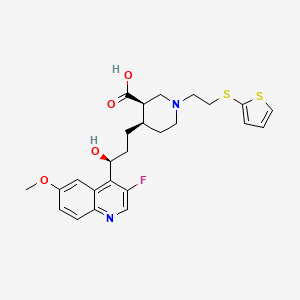
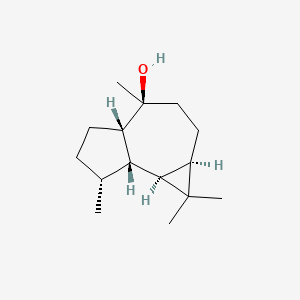
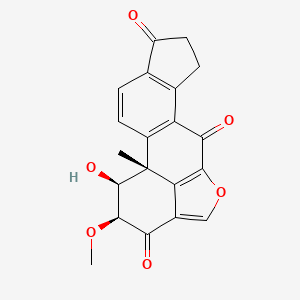
![Methyl 2-[8-[9,10-dihydroxy-7-methoxy-3-(2-methoxy-2-oxoethyl)-1-oxo-3,4-dihydrobenzo[g]isochromen-8-yl]-9,10-dihydroxy-7-methoxy-1-oxo-3,4-dihydrobenzo[g]isochromen-3-yl]acetate](/img/structure/B1683571.png)

![[(2R)-2-[[(Z)-octadec-9-enoyl]amino]-3-[4-(phenylmethoxy)phenyl]propyl] dihydrogen phosphate](/img/structure/B1683573.png)
